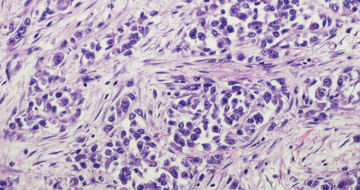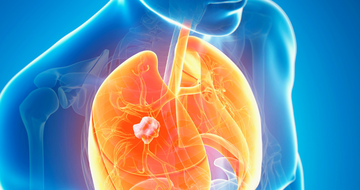What is the potential role for tislelizumab-jsgr in the treatment of advanced or metastatic squamous cell carcinoma?
Tislelizumab-jsgr is a programmed death receptor-1 (PD-1) blocking antibody indicated for the treatment of adult patients with unresectable or metastatic esophageal squamous cell carcinoma (ESCC) after prior systemic chemotherapy that did not include a programmed death ligand 1 (PD-(L)1) inhibitor. [1]
PD-1 is an immunosuppressive protein on the surface of T-cells. Binding of the PD-L1, which may be overexpressed on the surface of tumor cells, can suppress T-cell function and allow the tumor to evade T-cell surveillance. Tislelizumab-jsgr binds to PD-1 on T-cells, blocking the interaction between PD-1 and PD-L1 and preventing tumor cells from suppressing the immune response. [2]
Approval for this indication was based on RATIONALE-302, an open-label, randomized, active-controlled, multi-center, international, phase III clinical trial. [3,4]
- Methods:
- Between January 2018 and March 2020, RATIONALE-302 included 512 adult patients with histologically confirmed ESCC who had advanced or metastatic disease that progressed after first-line systemic treatment. Patients who received a prior immune checkpoint inhibitor were excluded. [3]
- Patients were enrolled regardless of tumor PD-L1 expression. [3]
- Eligible patients were randomly assigned (1:1) to receive tislelizumab-jsgr (200 mg intravenous (IV) every 3 weeks) or investigator’s choice of the following single agent chemotherapies: [3]
- Paclitaxel (80-100 mg/m2 IV weekly or 135-175 mg/m2 IV every 3 weeks at most sites except Japan, where it was administered as 100 mg/m2 IV weekly for 6 weeks, followed by one week of rest),
- Docetaxel (70-75 mg/m2 IV every 3 weeks), or
- Irinotecan (125 mg/m2 IV Days 1 and 8 of every 21-day cycle).
- The primary endpoint of the study was overall survival (OS) in the intent-to-treat (ITT) population. The key secondary endpoint was OS in patients with PD-L1 tumor area positivity (TAP) ≥10%. [3]
- Results:
- Of the 512 patients enrolled in RATIONALE-302, 256 patients (50%) were assigned to each arm and included in the ITT population.[3]
- PD-L1 TAP expression was ≥10% in 34.8% of patients in the tislelizumab-jsgr arm and 26.6% in the chemotherapy arm. [3]
- A statistically significant improvement in the primary endpoint of OS in the ITT population was seen in the tislelizumab-jsgr arm compared with single-agent chemotherapy arm (8.6 months vs. 6.3 months; HR 0.70; 95% CI, 0.57 to 0.85; one sided P=.00001). [3]
- Statistically significant improvement was also seen in the secondary endpoint of OS in patients with PD-L1 TAP score ≥10% (10.3 months in the tislelizumab-jsgr arm vs. 6.8 months in the single agent chemotherapy arm (HR 0.54; 95% CI, 0.36 to 0.79; one-sided P=.0006). [3]
- Adverse events that occurred in at least 10% of patients in the tislelizumab-jsgr arm were increased aspartate aminotransferase (11.4%), anemia (11%), and hypothyroidism (10.2%). 18.8% of patients in the tislelizumab-jsgr arm compared to 55.8% of patients in the chemotherapy arm experienced ≥ Grade 3 adverse events.[3]
- A subgroup analysis of RATIONALE-302 specific to patients from Europe and North America (n=108) also showed improvement in the primary and secondary outcomes in the tislelizumab-jsgr arm compared with the chemotherapy arm consistent with the results in the overall study population. Median OS in the ITT population of this subgroup analysis was 11.2 months vs. 6.3 months (HR 0.55; 95% CI 0.35-0.87). The OS HR for tislelizumab-jsgr vs. chemotherapy in patients with PD-L1 TAP score ≥ 10% was 0.47 (95% CI 0.18-1.21), while HR in patients with PD-L1 TAP score < 10% was 0.55 (95% CI 0.30-1.01). [4]
- Based on these results, the authors concluded that second-line tislelizumab-jsgr provided a statistically and clinically meaningful improvement in OS with a tolerable safety profile compared with single-agent chemotherapy in this patient population. [3]
The National Comprehensive Cancer Network (NCCN) clinical practice guideline for esophageal and esophagogastric junction cancers now includes tislelizumab-jsgr as a preferred regimen for second-line or subsequent therapy in locally advanced or metastatic ESCC (Category 1 recommendation). Other immune checkpoint inhibitors recommended as preferred regimens by NCCN for second-line treatment of ESCC include nivolumab (Category 1) and pembrolizumab for tumors with PD-L1 expression levels by combined positive score (CPS) of ≥ 10 (Category 1). Pembrolizumab, combination nivolumab / ipilimumab, and dostarlimab-gxly are also recommended in certain circumstances. [5]
There are no published head-to-head trials for immunotherapy agents within ESCC. Patient-specific characteristics, assessment of risk versus benefit, and toxicity profiles should guide drug therapy selection.
What role can the pharmacist play in the management of patients on tislelizumab-jsgr?
Pharmacists play an integral role in the management of patients on immunotherapy such as tislelizumab-jsgr, including by ensuring appropriate dosing and in the management of toxicity.
- Dosing [1]
- The labeled dosing for tislelizumab-jsgr is 200 mg as an IV infusion once every 3 weeks. The first infusion is administered over 60 minutes. If tolerated, subsequent infusions may be administered over 30 minutes. There are no dose adjustments recommended for renal or hepatic impairment.
- Immune-mediated adverse reactions [1]
- In the case of an occurrence of one or more immune-mediated adverse reactions, dose reduction of tislelizumab-jsgr is not recommended. In general, tislelizumab-jsgr should be held for severe (Grade 3) immune-mediated adverse reactions and permanently discontinued for life-threatening (Grade 4) or recurrent severe (Grade 3) immune-mediated reactions that require systemic immunosuppressive treatment, or an inability to reduce corticosteroid dose to 10 mg or less of prednisone equivalent per day within 12 weeks of initiating steroids.
- FDA label-recommended management of specific immune-mediated adverse reactions include the following:
- Pneumonitis: Withhold for Grade 2. Permanently discontinue for Grade 3 or 4 or recurrent Grade 2.
- Colitis: Withhold for Grade 2 or 3. Permanently discontinue for Grade 4.
- Hepatitis with no tumor involvement of the liver: For AST or ALT increases to more than 3 and up to 8 times the upper limit of normal (ULN) or total bilirubin increases to more than 1.5 and up to 3 times the ULN, withhold. For AST or ALT increases to more than 8 times ULN or total bilirubin increases to more than 3 times ULN, permanently discontinue.
- Hepatitis with tumor involvement of the liver: For baseline AST or ALT that is more than 1 and up to 3 times ULN and also increases to more than 5 and up to 10 times ULN or a baseline AST or ALT that is more than 3 and up to 5 times ULN and increases to more than 8 and up to 10 times ULN, withhold. When ALT or AST increases to more than 8 times ULN or total bilirubin increases to more than 3 times ULN, permanently discontinue.
- Endocrinopathies: For Grade 3 or 4, withhold until clinically stable or discontinue depending on severity.
- Nephritis with Renal Dysfunction: Withhold for Grade 2 or 3 increased blood creatinine. Permanently discontinue for Grade 4 increased blood creatinine.
- Exfoliative Dermatologic Conditions: Withhold for Grade 3 or suspected Stevens-Johnson Syndrome (SJS), Toxic Epidermal Necrolysis (TEN), or Drug Reaction with Eosinophilia and Systemic Symptoms (DRESS). Permanently discontinue for Grade 4 or confirmed SJS, TEN, or DRESS.
- Myocarditis: Permanently discontinue for Grade 2, 3, or 4.
- In addition to label-recommended toxicity management, pharmacists may reference immunotherapy-related toxicity management guidelines such as NCCN Management of Immunotherapy-Related Toxicities and/or American Society of Clinical Oncology (ASCO) Management of Immune-Related Adverse Events in Patients Treated with Immune Checkpoint Inhibitor Therapy. [6,7]
- Infusion-related reactions
- Pooled safety data showed that 4.2% (83/1972) of patients receiving tislelizumab-jsgr had an infusion-related reaction. 0.3% of patients had a Grade 3 or higher reaction. [1]
- Because of the risk of infusion-related reactions , the first infusion of tislelizumab-jsgr should be given over 60 minutes. If tolerated, subsequent infusions may be administered over 30 minutes. The label does not recommend specific premedications prior to infusion of tislelizumab-jsgr. [1]
- Label-recommended management of infusion-related reactions includes slowing the rate of infusion by 50% for Grade 1 reactions, interrupting infusions for Grade 2 reactions, or permanently discontinuing therapy for Grade 3 or 4 reactions. [1]
- Additionally, in the RATIONALE-302 study protocol, patients received premedication for subsequent infusions after a Grade 1 or Grade 2 infusion reaction. If the infusion rate was decreased, all subsequent infusions were given at the decreased rate. If a patient had a second infusion reaction (at least Grade 2) at the decreased infusion rate, the study drug was permanently discontinued. [3]
Clinical Pearls
- Patients who had tumor progression within 6 months of completing neoadjuvant or adjuvant therapy were also eligible for inclusion in RATIONALE-302. [3]
- PD-L1 expression was measured using the VENTANA PD-L1 (SP263) assay with tumor area positivity (TAP) score, and PD-L1-positivity in RATIONALE-302 was defined as TAP score ≥ 10%. [3] However, given that the survival benefit was observed regardless of PD-L1 expression, the approved indication does not require PD-L1 positivity. [1,3]
- Tislelizumab-jsgr can cause fetal harm. Female patients of reproductive potential should be counseled on the potential risk to a fetus and advised on use of effective contraception. [1]
- It is not advised to breastfeed while on tislelizumab-jsgr therapy. [1]
- At this time, there is no published information on patient assistance programs available for tislelizumab-jsgr.
References
- TEVIMBRA™ (tislelizumab-jsgr). Package insert. BeiGene Ltd.; March 2024. Accessed April 2, 2024.
- Alsaab HO, Sau S, Alzhrani R, et al. PD-1 and PD-L1 Checkpoint Signaling Inhibition for Cancer Immunotherapy: Mechanism, Combinations, and Clinical Outcome. Front Pharmacol. 2017;8:561. Published 2017 Aug 23. doi:10.3389/fphar.2017.00561
- Shen L, Kato K, Kim SB, et al. Tislelizumab Versus Chemotherapy as Second-Line Treatment for Advanced or Metastatic Esophageal Squamous Cell Carcinoma (RATIONALE-302): A Randomized Phase III Study [published correction appears in J Clin Oncol. 2024 Feb 1;42(4):486]. J Clin Oncol. 2022;40(26):3065-3076. doi:10.1200/JCO.21.01926
- Ajani J, El Hajbi F, Cunningham D, et al. Tislelizumab versus chemotherapy as second-line treatment for European and North American patients with advanced or metastatic esophageal squamous cell carcinoma: a subgroup analysis of the randomized phase III RATIONALE-302 study. ESMO Open. 2024;9(1):102202.
- National Comprehensive Cancer Network. NCCN Guidelines Version 3.2024 Esophageal and Esophagogastric Junction Cancers. Accessed April 2, 2024.
- National Comprehensive Cancer Network. NCCN Guidelines Version 1.2024 Management of Immunotherapy-Related Toxicities. Accessed April 5, 2024.
- Schneider BJ, Naidoo J, Santomasso BD, et al. Management of Immune-Related Adverse Events in Patients Treated With Immune Checkpoint Inhibitor Therapy: ASCO Guideline Update [published correction appears in J Clin Oncol. 2022 Jan 20;40(3):315]. J Clin Oncol. 2021;39(36):4073-4126. doi:10.1200/JCO.21.01440



